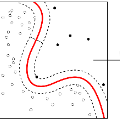Graph-level anomaly detection aims to identify anomalous graphs from a collection of graphs in an unsupervised manner. A common assumption of anomaly detection is that a reasonable decision boundary has a hypersphere shape, but may appear some non-conforming phenomena in high dimensions. Towards this end, we firstly propose a novel deep graph-level anomaly detection model, which learns the graph representation with maximum mutual information between substructure and global structure features while exploring a hypersphere anomaly decision boundary. The idea is to ensure the training data distribution consistent with the decision hypersphere via an orthogonal projection layer. Moreover, we further perform the bi-hypersphere compression to emphasize the discrimination of anomalous graphs from normal graphs. Note that our method is not confined to graph data and is applicable to anomaly detection of other data such as images. The numerical and visualization results on benchmark datasets demonstrate the effectiveness and superiority of our methods in comparison to many baselines and state-of-the-arts.
翻译:图形异常点检测旨在以不受监督的方式从图表集中找出异常图。异常点检测的一个常见假设是,合理的决定边界具有超视镜形状,但可能在某些高度上出现一些不相容的现象。为此,我们首先提出一个新的深图层异常点检测模型,该模型在探索超视镜异常决定界限的同时,以最高程度的相互信息学习图示和亚结构与全球结构特征之间的异常点检测。其想法是确保培训数据通过正方形投影层传播与决定超视镜相一致。此外,我们进一步进行双环镜压缩,以强调对正常图形的区别。请注意,我们的方法不限于图形数据,也适用于对图像等其他数据进行异常点检测。基准数据集的数字和可视化结果显示了我们方法与许多基线和状态条款相比的有效性和优越性。




